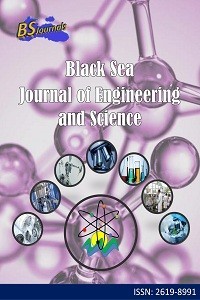Determination of Harness Production Time and Defective Product Formation Risk Factors with Artificial Neural Network
Machine learning, Artificial neural networks, Logistic regression analysis, Determination of risk factors
Determination of Harness Production Time and Defective Product Formation Risk Factors with Artificial Neural Network
Machine learning, Artificial neural networks, Logistic regression analysis, Determination of risk factors,
___
- Alpaydın E. 2010. Introduction to machine learning (Second edition). MIT Press, London, UK, pp: 537.
- Bayır F. 2006. An application on artificial neural networks and predictive modeling. Master Thesis, Istanbul University Institute of Social Sciences, Department of Business Administration, İstanbul, Türkiye, pp: 122.
- Beale MH, HaganMT, Demuth HB. 2010. Neural network toolbox 7 user’s guide. The MathWorks Inc., Natick, Massachusetts, US, pp: 424.
- Burduk A. 2013. Artificial neural networks as tools for controlling production systems and ensuring their stability. 12th International Conference on Information Systems and Industrial Management (CISIM), Computer Information Systems and Industrial Management, 25-27 October, 2013, Krakow, Poland, pp: 487-498.
- Chiang YM, Chang LC, Chang FJ. 2004. Comparison of static-feedforward and dynamic-feedback neural networks for rainfall–runoff modeling. J Hydrol, 209: 297-311.
- Elmas Ç. 2003. Artificial neural networks theory, architecture, education, practice (first edition). Seçkin Publishing, Ankara, Türkiye, pp: 192.
- Gürsoy A. 2012. Estimation of tire mold cost with artificial neural networks approach. Master Thesis, Kocaeli University Institute of Science and Technology, Department of Industrial Engineering, Kocaeli, Türkiye, pp: 102.
- Haykin S. 1994. Neural netwroks: A comprehensive foundation (First edition). Macmillan College Publishing, New York, Us, pp: 696.
- Jackson J. 2002. Data mining: A conceptual overview. Communication of the Association for Information System Magazine, 8(1): 267-296.
- Kalogirou SA. 2000. Applications of artifical neural-networks for energy systems. Appl Energy, 67(1): 17-35.
- Karabulut E, Alpar R. 2011. Logistic regression, applied multivariate statistical methods. Detay Publishing, Ankara, Türkiye, pp: 876.
- Kotsiantis SB. 2007. Supervised machine learning: A review of classification techniques. Informatica, 31(3): 249-268.
- Küçüksille E. 2009. Evaluation of portfolio performance using data mining process and an application in the ISE stock market. PhD Thesis, Süleyman Demirel University, Institute of Social Sciences, Department of Business Administration, Isparta, Türkiye, pp: 128.
- Kurt R, Karayılmazlar S, İmren E, Çabuk Y. 2017. Predictive modeling with artificial neural networks: The case of Turkish paper-cardboard industry. J Bartın Fac Forestry, 19(2): 99-106.
- Leech HL, Barrett KC, Morgan GA. 2004. Spss for intermediate statistics: use and interpretation (Second edition). Lawrance Erlbaum Associates Publishers, 240, Manwah New Jersey.
- Öğücü MO. 2006. System recognition with artificial neural networks. Master Thesis, Istanbul Technical University, Institute of Science and Technology, Department of Control and Automation Engineering, İstanbul, Türkiye, pp: 85.
- Öztemel E. 2003. Artificial neural network (first edition). Papatya Publishing, İstanbul, Türkiye, pp: 232.
- Pacci S, Safli ME, Odabas MS, Dengiz O. 2023. Variation of USLE-K soil erodibility factor and its estimation with artificial neural network approach in semi-humid environmental condition. Brazilian Arch Biol Technol, 66: e23220481.
- Tiryaki S, Bardak S, Bardak T. 2015. Experimental investigation and prediction of bonding strength of oriental beech (Fagus orientalis Lipsky) bonded with polyvinyl acetate adhesive. J Adhesion Sci Technol, 29(23): 2521-2536.
- Yayın Aralığı: 6
- Başlangıç: 2018
- Yayıncı: Uğur ŞEN
Estimation of Air Light With Deep Learning for a Near Real-Time Image Dehazing System
Forecasting Covid-19 Cases in Türkiye with the Help of LSTM
Malik ERGİN, Rabia ALBAYRAK DELİALİOĞLU, Yasin ALTAY, Özgür KOŞKAN
Bulut Servisleri ve Bulut Güvenliği için Ontoloji Tabanlı Hizmet Düzeyi Sözleşmeleri
Hayrettin KARADÖL, Ali ÇAYLI, Adil AKYÜZ, Serdar ÜÇOK
On Darboux Frames of Indicatrices of Spacelike Salkowski Curve with Spacelike Binormal in E13
Birkan AKSAN, Sümeyye GÜR MAZLUM
Determination of HMF Value and Diastase Activities in Strained Honeys Sold in Markets
Effects of High Level of Lead (II) Oxide (PbO) Usage on Accumulator and Response Surface Method
Emrah PIÇAKÇI, Zehra Gülten YALÇIN
A New Soluble Copper Phthalocyanine Derivative as a Smart Material
3 Boyutlu Görüntüleme Kullanılarak Bir Ağaç Gövde Çap Ölçüm Uygulamasının Geliştirilmesi
